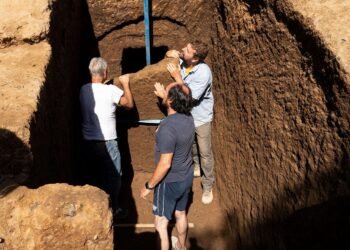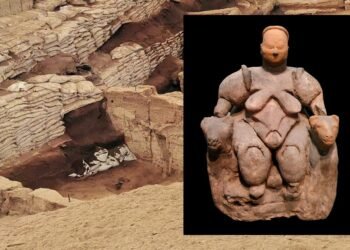A team of archaeologists have unearthed three Roman military encampments to the east of Bayir in Maan Governorate. These ancient Roman camps, which may have been constructed during a covert military operation in the second century CE, were identified using satellite imagery from Google Earth.
The Aerial Archaeology in Jordan project, on November 23, 2022, captured photographs of the western and central camps, as reported by The Jordan Times.
The confirmation of this discovery occurred in late April of the present year, said Michael Fradley, a landscape archaeologist associated with the Endangered Archaeology in the Middle East and North Africa (EAMENA) project.
This project is a collaboration between the University of Oxford, the University of Leicester, and the University of Durham.
In contrast to the numerous Roman camps found in Europe, only a small number have been discovered in the Middle East. Consequently, experts consider this finding to be a significant advancement in the field of archaeology.
According to a study published in the journal Antiquity on April 27, the camps can only be seen as rough outlines on Google Earth, as there are no remaining structures or tall walls.
The camps are situated in such a remote desert area that no scientists have physically visited them; however, tire tracks indicate the presence of several vehicles in the vicinity.
Dr. Fradley asserts that there is little doubt regarding the camps’ age, stating, “Given the characteristic shape of the enclosures with opposing entrances on each side, we are almost certain they were constructed by the Roman army.”
The primary distinction between the camps is that the largest one is located in the westernmost position, while the other two camps lie to the east. Each camp is approximately 44 kilometers apart, with the eastern camp positioned near the border of Saudi Arabia.
Although the exact strategic purpose of the camps is not yet confirmed, they are clearly heading in the direction of Dumas Al Jandal in Saudi Arabia, which served as a settlement on the eastern boundary of the Nabataean Kingdom, as per Fradley’s remarks.
Fradley stated that, based on this evidence, we speculate that these camps might have been part of a military campaign aimed at suppressing resistance in the region when the Romans annexed the Nabataean Kingdom.”
If the objective was to reach Dumat Al Jandal, it would have been more convenient to travel south from Azraq along the comparatively well-watered Wadi Sirhan. However, these camps are situated in arid areas with challenging terrain, which could imply that the Roman army intended to surprise the region, Fradley said.
Roman historical records indicate that following the death of the Nabataean king in 106 CE, the kingdom peacefully transitioned into direct Roman governance under Emperor Trajan. Nevertheless, these new discoveries suggest that the shift to Roman rule may have been more tumultuous than previously believed, Fradley added.
The dimensions of the western camp are approximately 125m by 105m, while the central and eastern camps are smaller, measuring around 95m by 65m.
Inside the camps, there are identifiable indications of internal divisions arranged in straight lines. The camps are situated at a distance greater than what an individual could easily cover on foot within a day.
Fradley’s estimation suggests that these camps likely accommodated hundreds of mounted troops, potentially utilizing camels.
Currently, there are no concrete plans for the team to conduct surveys of the sites, but they express their desire to assist their Jordanian colleagues in future investigations of the camps.
The project receives support from the Arcadia Fund, an organization that utilizes satellite imagery to identify and monitor the condition of archaeological sites.






















